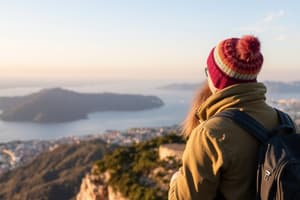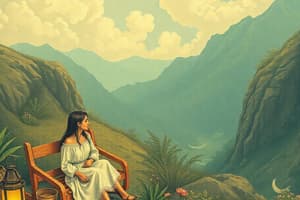Podcast
Questions and Answers
Who is known as the Father of History?
Who is known as the Father of History?
Herodotus
Marco Polo was the first person to write his adventures.
Marco Polo was the first person to write his adventures.
True (A)
What is the oldest guidebook ever written?
What is the oldest guidebook ever written?
Hellados Periegesis or Description of Greece
Which of the following is a critical element of writing authentic travel articles?
Which of the following is a critical element of writing authentic travel articles?
What is one suggested method for writing authentic travel articles?
What is one suggested method for writing authentic travel articles?
Which of the following should be avoided in travel writing?
Which of the following should be avoided in travel writing?
Pausanias is recognized as the first _______ writer/historian.
Pausanias is recognized as the first _______ writer/historian.
What is an essential aspect of travel journalism?
What is an essential aspect of travel journalism?
Immediacy in travel journalism means information is available to all people.
Immediacy in travel journalism means information is available to all people.
Match the following elements of travel journalism with their descriptions:
Match the following elements of travel journalism with their descriptions:
Flashcards are hidden until you start studying
Study Notes
Travel Journalism Overview
- Travel record literature emerged in the 1300s in China, blending narrative, prose, essay, and diary formats.
- Accounts served an agenda, mapping cultural and topographical landscapes akin to cartography.
- Key historical figures include:
- Herodotus: Known as the "Father of History," the first historian to document events of his time.
- Pausanias: Authored Hellados Periegesis (Description of Greece), the earliest guidebook, pioneering the travel literature genre.
- Marco Polo: Great traveler and writer, his writings formed the basis of early European exploration narratives.
Evolution of Travel Writing
- Travel writing describes places visited and experiences encountered.
- Transition from traditional travel narratives, focused on personal journeys, to modern formats resembling blogs with advice and tips.
Writing Authentic Stories
- Authentic travel articles require a foundation of creativity, research, and understanding of human emotions.
- Ensuring accurate descriptions while capturing the essence of a destination is vital.
Steps to Crafting Engaging Travel Articles
- Observe and Experience: Draw inspiration from personal observations of people and places, focusing on relatable human experiences.
- Research: Conduct thorough research on specific settings, cultures, and histories to ensure accuracy and depth.
- Choose a Unique Angle: Select specific themes such as local cuisine, festivals, or adventure activities to distinguish the article.
- Share Personal Experiences: Convey feelings and lessons learned from the visit to connect with readers.
- Show, Don't Just Tell: Use descriptive language and sensory details to immerse readers in the experience.
- Highlight Uniqueness: Identify and portray what makes a destination special, including views or traditions.
- Address Practicalities: Include details like accommodation, transportation, and local customs for a well-rounded article.
- Respect Cultural Sensitivities: Avoid stereotypes and ensure respectful representation of local traditions and sensitivities.
- Structure: Organize logically, starting with an engaging introduction, followed by the body, and concluding reflections.
- Engage the Senses: Use descriptions that encompass the five senses to create an immersive experience.
Key Concepts in Travel Journalism
- Public Service vs. Consumer Service: Travel journalism can be both comprehensive for the public and niche-targeted for specific interests.
- Objectivity: Commitment to truthfulness in reporting.
- Transparency: Clarity on how information is gathered.
- Immediacy & Accessibility: Ensuring news is timely and available to the public.
- Exclusivity: Creating content that holds unique influence or impact.
Types of Travel News and Reporting
- Travel journalism encompasses more than lifestyle topics; it involves significant social and governmental issues.
- Categories of travel journalism include:
- Traditional News Stories: Follows the 4W1H format (Who, What, When, Where, How) for informative reporting.
- Revisiting the Old: Updating or exploring historic places.
- Trend Spotting: Identifying and reporting on currently trending topics in travel.
Crafting Travel Narratives and Blogs
- Creating compelling travel narratives emphasizes capturing personal experiences and insights, engaging the reader through storytelling techniques and vivid descriptions.
Studying That Suits You
Use AI to generate personalized quizzes and flashcards to suit your learning preferences.




